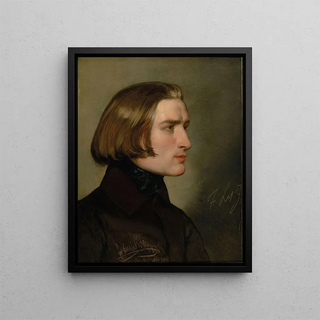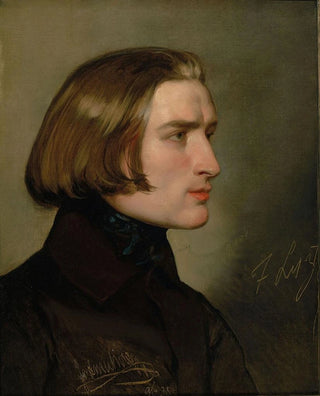Art print | Portrait of Franz Liszt - Friedrich von Amerling


View from behind

Frame (optional)
Franz Liszt Portrait - Friedrich von Amerling – Captivating Introduction
The "Franz Liszt Portrait" by Friedrich von Amerling is a work that transcends the simple frame of painting to offer an immersion into the musical and romantic universe of the 19th century. This depiction of the illustrious composer and pianist, renowned for his genius and passion, evokes an emotional depth that still resonates today. Amerling, a master of portraiture, manages to capture not only Liszt's physical features but also his essence, charisma, and virtuoso aura. Through this artwork, viewers are invited to explore the nuances of a man whose music marked an era.
Style and uniqueness of the work
Amerling's technique stands out for its striking realism and meticulous attention to detail. In this portrait, the artist uses a palette of rich and harmonious colors, creating a subtle contrast between light and shadow. Liszt's face, delicately illuminated, appears almost alive, as if it could animate at any moment to perform one of his famous compositions. The musician's posture, both relaxed and majestic, reflects his self-confidence and dedication to art. Every brushstroke, every reflection in his eyes, tells a story—the story of a man seeking expression through music. The work is also distinguished by its background, which, though understated, highlights the central figure, thus emphasizing Liszt's commanding presence.
The artist and his influence
Friedrich von Amerling, an Austrian-born painter, is recognized for his ability to immortalize emblematic figures of his time. Trained in the most prestigious ateliers, he develops a style that combines romanticism with academic rigor. His work is not limited to portraits of celebrities but also extends to representations of daily life and historical scenes. Amerling's influence in the art world is undeniable; he captured the spirit of his era while leaving a lasting imprint on future generations of artists. The choice of Liszt as a subject reflects his interest in personalities shaping culture and society. Through this portrait, Amerling does not merely

Matte finish

View from behind

Frame (optional)
Franz Liszt Portrait - Friedrich von Amerling – Captivating Introduction
The "Franz Liszt Portrait" by Friedrich von Amerling is a work that transcends the simple frame of painting to offer an immersion into the musical and romantic universe of the 19th century. This depiction of the illustrious composer and pianist, renowned for his genius and passion, evokes an emotional depth that still resonates today. Amerling, a master of portraiture, manages to capture not only Liszt's physical features but also his essence, charisma, and virtuoso aura. Through this artwork, viewers are invited to explore the nuances of a man whose music marked an era.
Style and uniqueness of the work
Amerling's technique stands out for its striking realism and meticulous attention to detail. In this portrait, the artist uses a palette of rich and harmonious colors, creating a subtle contrast between light and shadow. Liszt's face, delicately illuminated, appears almost alive, as if it could animate at any moment to perform one of his famous compositions. The musician's posture, both relaxed and majestic, reflects his self-confidence and dedication to art. Every brushstroke, every reflection in his eyes, tells a story—the story of a man seeking expression through music. The work is also distinguished by its background, which, though understated, highlights the central figure, thus emphasizing Liszt's commanding presence.
The artist and his influence
Friedrich von Amerling, an Austrian-born painter, is recognized for his ability to immortalize emblematic figures of his time. Trained in the most prestigious ateliers, he develops a style that combines romanticism with academic rigor. His work is not limited to portraits of celebrities but also extends to representations of daily life and historical scenes. Amerling's influence in the art world is undeniable; he captured the spirit of his era while leaving a lasting imprint on future generations of artists. The choice of Liszt as a subject reflects his interest in personalities shaping culture and society. Through this portrait, Amerling does not merely






